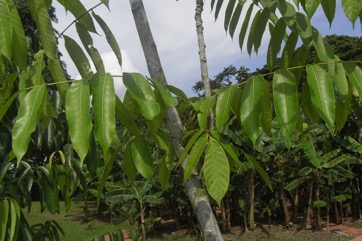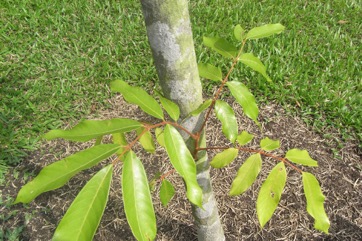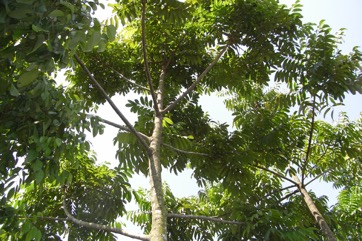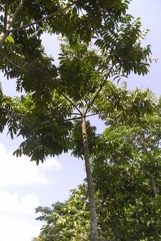Chinese white olive

It is a subtropical and tropical plant. It grows in forest in north Vietnam below 500 m altitude. It needs light to grow. In Yunnan, China it grows between 600-1300 m altitude. It grows in deep humid and fertile soil. It can grow under light shade. In Sichuan.
Also known as:
Ca-na, Cay ca-na, Ch'ing-kuo, Ganlan, Larm yin, Maizhahang, Mane, Olive nut, Paak-laam, Samo cheen, Talatt, Tonkin canarium, Tram chim, Tram trang, Wu Lam, Xica, Ximo
Synonyms
- Canarium album Leenh.
- Canarium tonkinense Engl.
- Hearnia balansae C. DC.
- Pimela alba Lour.
Edible Portion
- Fruit, Seeds - oil, Seeds, Nuts
Where does Chinese white olive grow?
Found in: Asia, Cambodia, China, Indochina, Indonesia, Japan, Laos, Malaysia, Pacific, Philippines, SE Asia, Taiwan, Thailand, Vietnam
Notes: There are 80-95 Canarium species.
Status: It is a cultivated crop. Fruit are sold in markets. It is a priority under-utilised crop for China.
Growing Chinese white olive
Cultivation: Plants can be grown by seeds.
Edible Uses: The fruit are eaten like olives. The fruit are soaked in tubs of salt water, then dried. They are also preserved as a condiment. They are also used for wines and drinks. The seed contains an edible oil. The oil should not be too hot as seeds burn easily. The seed kernels are eaten. The fruit are edible when mature. They are also pickled.
Production: Trees are fast growing. They flower in January and February and fruit in June and July. In southern China fruit are available in June to August.
Nutrition Info
per 100g edible portion| Edible Part | Energy (kcal) | Protein (g) | Iron (mg) | Vitamin A (ug) | Vitamin c (mg) | Zinc (mg) | % Water |
|---|---|---|---|---|---|---|---|
| Fruit | 72 | 1.2 | 2.1 | - | 5 | - | 80.2 |
| Nuts | - | - | - | - | - | - | |
| Nuts - oil | - | - | - | - | - | - |
Chinese white olive Photos




References
Altschul, S.V.R., 1973, Drugs and Foods from Little-known Plants. Notes in Harvard University Herbaria. Harvard Univ. Press. Massachusetts. no. 1976
Bircher, A. G. & Bircher, W. H., 2000, Encyclopedia of Fruit Trees and Edible Flowering Plants in Egypt and the Subtropics. AUC Press. p 78, p 79 (As Canarium tonkinensis)
Burkill, I.H., 1966, A Dictionary of the Economic Products of the Malay Peninsula. Ministry of Agriculture and Cooperatives, Kuala Lumpur, Malaysia. Vol 1 (A-H) p 430
Cengel, D. J. & Dany, C., (Eds), 2016, Integrating Forest Biodiversity Resource Management and Sustainable Community Livelihood Development in the Preah Vihear Protected Forest. International Tropical Timber Organization p 120
Facciola, S., 1998, Cornucopia 2: a Source Book of Edible Plants. Kampong Publications, p 62
Forest Inventory and Planning Institute, 1996, Vietnam Forest Trees. Agriculture Publishing House p 80
Ghorbani, A., et al, 2012, Diversity of Medicinal and Food Plants as Non-timber Forest Products. Economic Botany XX (X) 2012, pp 1-14 (As Canarium tonkinensis)
Hedrick, U.P., 1919, (Ed.), Sturtevant's edible plants of the world. p 148
Hill, M. & Hallam, D., (eds), 1997, Na Hang Nature Reserve, Tat Ke Sector. Site description and conservation evaluation. Hanoi. p 72
Hu, Shiu-ying, 2005, Food Plants of China. The Chinese University Press. p 505, p 506 (As Canarium tonkinensis)
Jin, Chen et al, 1999, Ethnobotanical studies on Wild Edible Fruits in Southern Yunnan: Folk Names: Nutritional Value and Uses. Economic Botany 53(1) pp 2-14
Kiple, K.F. & Ornelas, K.C., (eds), 2000, The Cambridge World History of Food. CUP p 1755
Kuo, W. H. J., (Ed.) Taiwan's Ethnobotanical Database (1900-2000), http://tk.agron.ntu.edu.tw/ethnobot/DB1.htm
Leenhouts, 1959, Blumea 9(2):402-405
Luo, B., et al, 2019, Wild edible plants collected by Hani from terraced rice paddy agroecosystem in Honghe Prefecture, Yunnan, China. Journal of Ethnobiology and Ethnomedicine 15:56
Macmillan, H.F. (Revised Barlow, H.S., et al) 1991, Tropical Planting and Gardening. Sixth edition. Malayan Nature Society. Kuala Lumpur. p 313
Martin, F. W., et al, 1987, Perennial Edible Fruits of the Tropics. USDA Handbook 642 p 19
Nomencl. bot. ed. 3, 287. 1797 (DC., Prodr. 2:80. 1825)
Rehm, S., & Espig, G., 1991, The cultivated plants of the tropics and subtropics.
Sam, H. V. et al, 2004, Trees of Laos and Vietnam: A Field Guide to 100 Economically or Ecologically Important Species. BLUMEA 49: 201-349
Sang, D. T., & Mizoue, K. O. N., 2012, Use of Edible Forest Plants among Indigenous Ethnic Minorities in Cat Tien Biosphere Reserve, Vietnam. Asian Journal of Biodiversity Vol. 3 (1), p 23-49
Soepadmo, E. and Wong, K. M., 1995, Tree Flora of Sabah and Sarawak. Forestry Malaysia. Volume One. p 48
Solomon, C., 2001, Encyclopedia of Asian Food. New Holland. p 260
Steenis, ed, Flora Malesiana
Terrell, 1986, Agricultural handbook no 505,
USDA, ARS, National Genetic Resources Program. Germplasm Resources Information Network - (GRIN). [Online Database] National Germplasm Resources Laboratory, Beltsville, Maryland. Available: www.ars-grin.gov/cgi-bin/npgs/html/econ.pl (10 April 2000)
Valder, P., 1999, The Garden Plants of China. Florilegium. p 269
Van Sam, H. et al, 2004, Trees of Laos and Vietnam: A Field Guide to 100 Economically or Ecologically Important Species. Blumea 29 (2004) 201-349
Van Sam, H. et al, 2008, Uses and Conservation of Plant Species in a National Park. A case study of Ben En, Vietnam. Economic Botany 62:574-593
Wickens, G.E., 1995, Edible Nuts. FAO Non-wood forest products. FAO, Rome. p 111
World Checklist of Useful Plant Species 2020. Royal Botanic Gardens, Kew
Xu, You-Kai, et al, 2004, Wild Vegetable Resources and Market Survey in Xishuangbanna, Southwest China. Economic Botany. 58(4): 647-667.